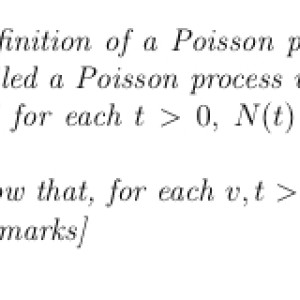Operational Research probabilistic models
Recall the following definition of a Poisson process with rate λ > 0 : a counting process {N(t)} with N(0) = 0 is called a Poisson process with rate λ if the following are true: it has independent increments; and for each t > 0, N(t) is a Poisson random variable with parameter λt. Using the above definition to show that, for each v, t > 0, N(t + v) − N(t) follows Poisson distribution with parameter λv. [20 marks]
 Pipe98
Pipe98
20
Answer
Answers can only be viewed under the following conditions:
- The questioner was satisfied with and accepted the answer, or
- The answer was evaluated as being 100% correct by the judge.
4.8K
-
I meant " Probability of n occurrences ... "
The answer is accepted.
Join Matchmaticians Affiliate Marketing
Program to earn up to a 50% commission on every question that your affiliated users ask or answer.
- answered
- 1439 views
- $5.00
Related Questions
- foundations in probability
- Joint PDF evaluated over a curve $P_{U,V}$
- Help with probability proofs and matrices proofs (5 problems)
- Discrete Structures - Proving a statement false by proving the negation to be true
- Probability question, joint probability distribution
- Insurance question involving net premium
- Check if problems are correct
- Applied Probability

